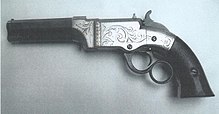Volcanic rifle
| Company type | Private |
|---|---|
| Industry | Weapons |
| Predecessor | Smith & Wesson Company |
| Founded | 1855 |
| Founders | Horace Smith; Daniel B. Wesson |
| Defunct | 1856 |
| Fate | Acquired |
| Successor | New Haven Arms Company |
| Headquarters | , United States |
Key people | Horace Smith; Daniel B. Wesson; Benjamin Tyler Henry; Oliver Winchester; Courtlandt Palmer |
| Products | Rifles, Pistols, Ammunition |
The Volcanic Repeating Arms Company was an American company formed in 1855 by partners Horace Smith and Daniel B. Wesson to develop Walter Hunt's Rocket Ball ammunition and lever action mechanism. Volcanic made an improved version of the Rocket Ball ammunition, and a carbine and pistol version of the lever action gun to fire it. While the Volcanic Repeating Arms Company was short-lived, its descendants, Winchester Repeating Arms Company and Smith & Wesson became major firearms manufactures.


History
The original 1848 Volcanic Repeating Rifle design by Hunt was revolutionary, introducing an early iteration of the lever action repeating mechanism and the tubular magazine still common today. However, Hunt's design was far from perfect, and only a couple of prototypes were developed; the only one known is currently in the Firearms Museum in Cody, Wyoming. Lewis Jennings patented an improved version of Hunt's design in 1849, and versions of the Jenning's patent design were built by Robbins & Lawrence Co. (under the direction of shop foreman Benjamin Tyler Henry) and sold by C. P. Dixon. Horace Smith was also hired by Courtlandt Palmer to improve the Jennings Rifle, patenting the Smith-Jennings in 1851. It is estimated that fewer than 2000 of these two models were made until 1852, when financial troubles ceased production.[1][2]
In 1854, partners Horace Smith and Daniel B. Wesson joined with Courtlandt Palmer, the businessman who had purchased the Jennings and Smith-Jennings patent rights,[3] and further improved on the operating mechanism, developing the Smith & Wesson Lever pistol, and a new Volcanic cartridge. Production was in the shop of Horace Smith in Norwich, Connecticut. The new cartridge improved upon the Hunt Rocket Ball with the addition of a primer. Originally using the name "Smith & Wesson Company", the name was changed to "Volcanic Repeating Arms Company" in 1855, with the addition of new investors, one of which was Oliver Winchester. The Volcanic Repeating Arms Company obtained all rights for the Volcanic designs (both rifle and pistol versions were in production by this time) as well as the ammunition, from the Smith & Wesson Company. Wesson remained as plant manager for 8 months before rejoining Smith to found the "Smith & Wesson Revolver Company" upon obtaining the licensing of the Rollin White rear loading cylinder patent.

Winchester forced the insolvency of the Volcanic Arms Company in late 1856, took over ownership and moved the plant to New Haven, Connecticut, where it was reorganized as the New Haven Arms Company in April 1857. B. Tyler Henry was hired as plant superintendent when Robbins & Lawrence suffered financial difficulties and Henry left their employ. While continuing to make the Volcanic rifle and pistol, Henry began to experiment with the new rimfire ammunition, and modified the Volcanic lever action design to use it. The result was the Henry rifle. By 1866, the company once again reorganized, this time as the Winchester Repeating Arms company, and the name of Winchester became synonymous with lever action rifles.[2][4][5]
Gallery
- Examples of Volcanic Repeating Arms
-
A Volcanic pistol in .41 caliber
-
A Volcanic pistol, circa 1855 in .31 caliber
-
The Jennings (top) and Volcanic (bottom) rifles
In popular culture
Set in 1875, Have Gun Will Travel Radio Episode "Landfall" aired November 08, 1959. A character offers Paladin use of his Jennings rifle.
The Rider, the title character of Edward M. Erdelac's Judeocentric Lovecraftian weird west series Merkabah Rider, carries a Volcanic pistol inlaid with gold and silver and bearing various Solomonic talismans and wards, including a jeweled Tree of Sephiroth on the handle.[6]
It also features as one of the weapon cards in the Spaghetti Western-themed card game Bang!.
In the 2005 videogame “Gun”, a weapon called the “Volcanic 10” is unlocked as a pistol. The pistol is fired and reloaded as a revolver in the game, however, it holds 10 shots.
The 2007 videogame "Fistful of Frags" also features the Volcanic pistol as a weapon.
The Volcanic pistol is one of the many sidearms the player can get in the 2010 Western videogame Red Dead Redemption, as well as its 2018 sequel, Red Dead Redemption 2, and its online multiplayer expansion, Red Dead Online.
References
- ^ Jim Taylor. "Leverguns: A Short History".
- ^ a b Charles Winthrop Sawyer (1920). Firearms in American History. Charles Winthrop Sawyer.
- ^ Henshaw, Thomas (1993). The History of Winchester Firearms 1866-1992. Academic Learning Company LLC. p. 3. ISBN 978-0-8329-0503-2.
- ^ "A Guide to Ammunition Collecting". International Ammunition Association.
- ^ Daniel Coit Gilman; Harry Thurston Peck; Frank Moore Colby (1904). The New International Encyclopædia. Dodd, Mead and Company.
- ^ Erdelac, Edward M. (2009). Merkabah Rider: Tales of a High Planes Drifter. Damnation Books. p. 9. ISBN 978-1-61572-061-3.
Bibliography
- Flayderman, E. Norman: "Flayderman's Guide to Antique Firearms and their Values 9th edition" Gun Digest Books, 2007
- Houze, Herbert G.: "Winchester Repeating Arms Company; Its History and Development from 1865 to 1981" Krause Publication. 1994
- Lewis, Col. B. R.: "The Volcanic Arms"; American Rifleman, November 1957
- Madis, George: "The Winchester Book"; Art and Reference House. 1985
- McDowell, R. Bruce; "Evolution of the Winchester"; Armory Publications, 1985
- Edsall, James: "Volcanic Firearms - And Their Successors"; Pioneer Press, 1974
- Internet Movie Firearms Database: For a Few Dollars More. Last edit, 15 May 2012.



